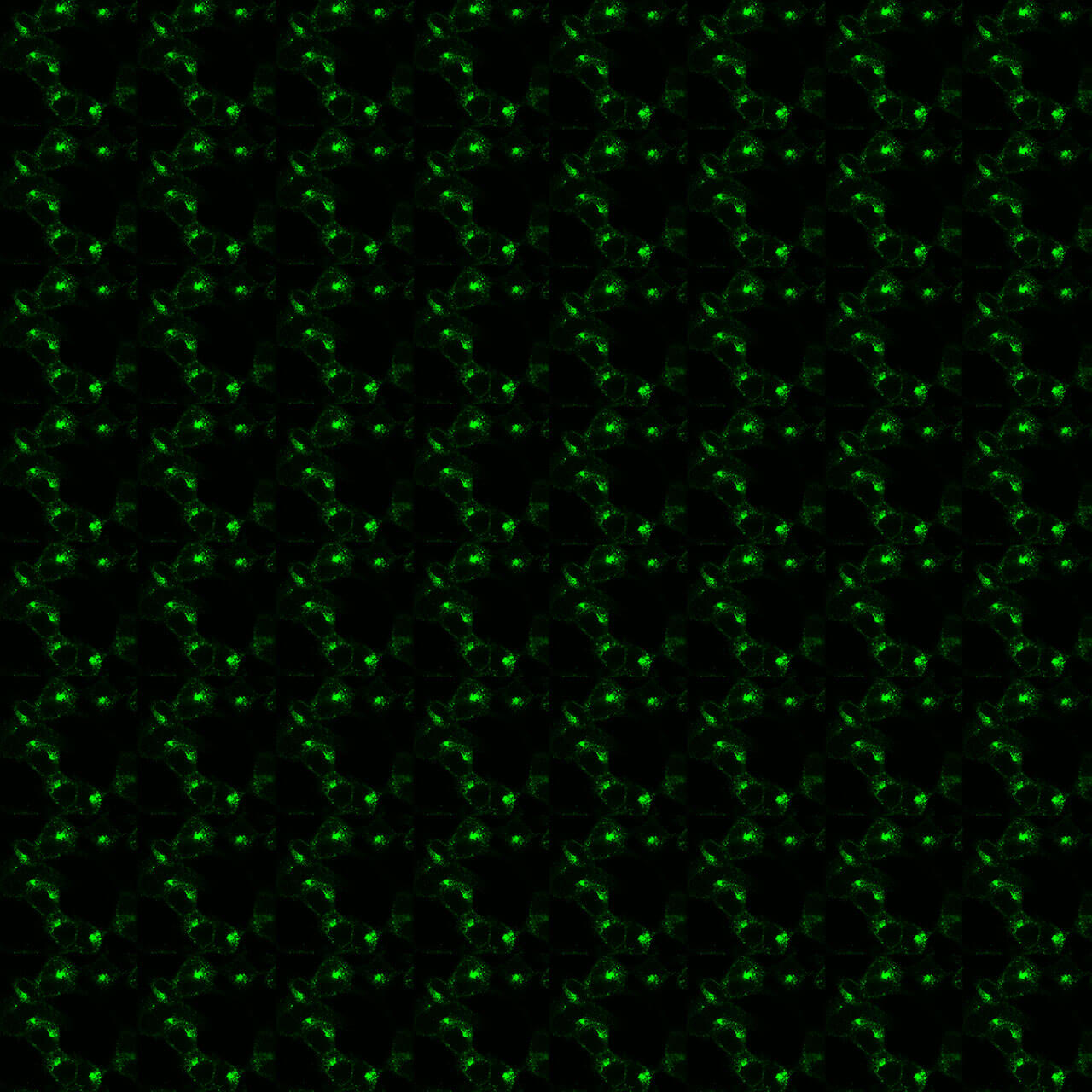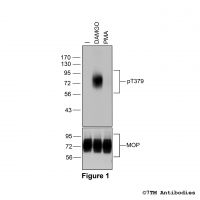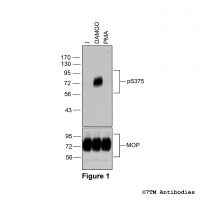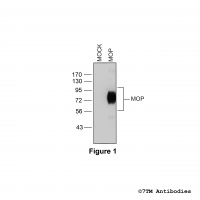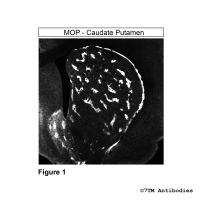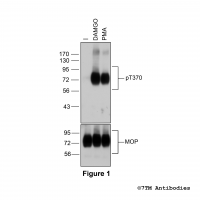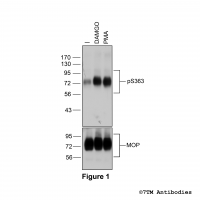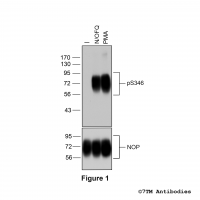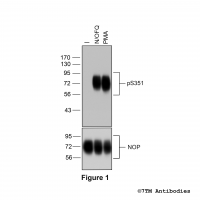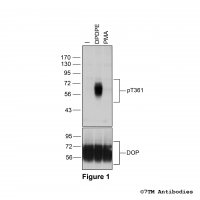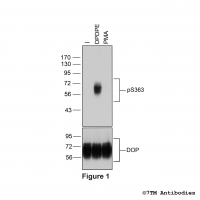Prices plus VAT plus shipping costs
Ready to ship today,
Delivery time appr. 5-8 days
- Order number: 7TM0319E
- Content: 100 µl
- Host: Rabbit
Threonine379 (T379) is a major phosphorylation site of the µ-opioid receptor (MOP). The pT379-MOP antibody detects phosphorylation in response to high-efficacy agonists but to low-efficacy agonists or after PKC activation. T379 phosphorylation is a key regulator of MOP desensitization, β-arrestin recruitment and tolerance.
| Alternative Names | MOP, OPRM1, µ-Opioid Receptor, Mu Receptor |
| IUPHAR Target ID | 319 |
| UniProt ID | P35372 (human) P42866 (mouse) P33535 (rat) |
| Western Blot (WB) | 1:1000 |
| Species Reactivity | Human, Mouse, Rat |
| Host / Isotype | Rabbit / IgG |
| Class | Polyclonal |
| Immunogen | A synthetic phosphopeptide derived from human MOP around the phosphorylation site of Thr379 |
| Form | Liquid |
| Purification | Antigen affinity chromatography |
| Storage buffer | Dulbecco's PBS, pH 7.4, with 150 mM NaCl, 0.02% sodium azide |
| Storage conditions | short-term 4°C, long-term -20°C |
Figure 1. Agonist-induced Threonine379 phosphorylation of the µ-Opioid Receptor. Upper panel, HEK293 cells stably expressing the µ-Opioid Receptor (MOP) were either not exposed or exposed to 10 μM DAMGO ([D-Ala2,N-MePhe4, Gly-ol]-enkephalin) or 0.1 μM PMA (Phorbol 12-Myristate 13-Acetate) for 30 minutes. Cells were lysed and immunoblotted with the anti-pT379-MOP antibody (7TM0319E) at a dilution of 1:1000. Lower panel, blot was stripped and reprobed with the phosphorylation-independent anti-MOP antibody (7TM0319N-WB) at a dilution of 1:1000 to confirm equal loading of the gel.
Figure 2. Analysis of dose-dependent µ-Opioid Receptor phosphorylation using a panel of phosphosite-specific antibodies. Upper four panels, HEK293 cells stably expressing the µ-Opioid Receptor (MOP) were either not exposed or exposed to increasing concentrations of DAMGO ([D-Ala2,N-MePhe4, Gly-ol]-enkephalin) ranging from 1 nM to 1 μM for 30 minutes. Cells were lysed and immunoblotted with the anti-pT370-MOP antibody (7TM0319B) or anti-pS375-MOP antibody (7TM0319C) or anti-pT376-MOP antibody (7TM0319D) or anti-pT379-MOP antibody (7TM0319E) at a dilution of 1:1000. Lower panel, blot was stripped and reprobed with the phosphorylation-independent anti-MOP antibody (7TM0319N-WB) at a dilution of 1:1000 to confirm equal loading of the gel. Note, Serine375 is the primary site of phosphorylation.
Figure 3. Analysis of agonist-selective µ-Opioid Receptor phosphorylation using a panel of phosphosite-specific antibodies. Upper 4 panels, HEK293 cells stably expressing the µ-Opioid Receptor (MOP) were either not exposed or exposed to 10 µM morphine or 10 µM DAMGO ([D-Ala2,N-MePhe4, Gly-ol]-enkephalin) for 30 minutes. Cells were lysed and immunoblotted with the anti-pT370-MOP antibody (7TM0319B) or anti-pS375-MOP antibody (7TM0319C) or anti-pT376-MOP antibody (7TM0319D) or anti-pT379-MOP antibody (7TM0319E) at a dilution of 1:1000. Lower panel, blot was stripped and reprobed with the phosphorylation-independent anti-MOP antibody (7TM0319N-WB) at a dilution of 1:1000 to confirm equal loading of the gel. Note, DAMGO induces multisite phosphorylation. Morphine induces primarily the phosphorylation of Serine375.
Kliewer A, Schmiedel F, Sianati S, Bailey A, Bateman JT, Levitt ES, Williams JT, Christie MJ, Schulz S. Phosphorylation-deficient G-protein-biased μ-opioid receptors improve analgesia and diminish tolerance but worsen opioid side effects. Nat Commun. 2019 Jan 21;10(1):367. doi: 10.1038/s41467-018-08162-1. PubMed PMID: 30664663; PubMed Central PMCID: PMC6341117.
Miess E, Gondin AB, Yousuf A, Steinborn R, Mösslein N, Yang Y, Göldner M, Ruland JG, Bünemann M, Krasel C, Christie MJ, Halls ML, Schulz S, Canals M. Multisite phosphorylation is required for sustained interaction with GRKs and arrestins during rapid μ-opioid receptor desensitization. Sci Signal. 2018 Jul 17;11(539). pii: eaas9609. doi: 10.1126/scisignal.aas9609. PubMed PMID: 30018083.
Yousuf A, Miess E, Sianati S, Du YP, Schulz S, Christie MJ. Role of Phosphorylation Sites in Desensitization of µ-Opioid Receptor. Mol Pharmacol. 2015 Oct;88(4):825-35. doi: 10.1124/mol.115.098244. Epub 2015 May 12. PubMed PMID: 25969388.
Just S, Illing S, Trester-Zedlitz M, Lau EK, Kotowski SJ, Miess E, Mann A, Doll C, Trinidad JC, Burlingame AL, von Zastrow M, Schulz S. Differentiation of opioid drug effects by hierarchical multi-site phosphorylation. Mol Pharmacol. 2013 Mar;83(3):633-9. doi: 10.1124/mol.112.082875. Epub 2012 Dec 13. PubMed PMID: 23239825; PubMed Central PMCID: PMC3583494.
Dasgupta P, Mann A, Polgar WE, Reinscheid RK, Zaveri NT, Schulz S. Attenuated G protein signaling and minimal receptor phosphorylation as a biochemical signature of low side-effect opioid analgesics. Sci Rep. 2022 May 3;12(1):7154. doi: 10.1038/s41598-022-11189-6. PMID: 35504962; PMCID: PMC9065038.
Doll C, Pöll F, Peuker K, Loktev A, Glück L, Schulz S. Deciphering µ-opioid receptor phosphorylation and dephosphorylation in HEK293 cells. Br J Pharmacol. 2012 Nov;167(6):1259-70. doi: 10.1111/j.1476-5381.2012.02080.x. PubMed PMID: 22725608; PubMed Central PMCID: PMC3504992.
Doll C, Konietzko J, Pöll F, Koch T, Höllt V, Schulz S. Agonist-selective patterns of µ-opioid receptor phosphorylation revealed by phosphosite-specific antibodies. Br J Pharmacol. 2011 Sep;164(2):298-307. doi: 10.1111/j.1476-5381.2011.01382.x. PubMed PMID: 21449911; PubMed Central PMCID: PMC3174411.
Celik MÖ, Seitz V, Yergöz F, Dembla S, Blum NK, Schulz S, Stein C. Modulation of G-protein activation, calcium currents and opioid receptor phosphorylation by the pH-dependent antinociceptive agonist NFEPP. Front Mol Neurosci. 2023 May 12;16:1171855. doi: 10.3389/fnmol.2023.1171855. PMID: 37251645; PMCID: PMC10213447.
Underwood O, Fritzwanker S, Glenn J, Blum NK, Batista-Gondin A, Drube J, Hoffmann C, Briddon SJ, Schulz S, Canals M. Key phosphorylation sites for robust β-arrestin2 binding at the MOR revisited. Commun Biol. 2024 Aug 2;7(1):933. doi: 10.1038/s42003-024-06571-1. PMID: 39095612; PMCID: PMC11297201.

